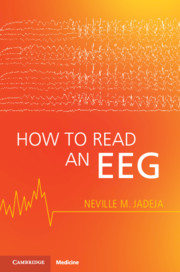Book contents
- How to Read an EEG
- How to Read an EEG
- Copyright page
- Dedication
- Contents
- Figure Contributions
- Foreword
- Preface
- How to Read This Book
- Part I Basics
- Part II Interpretation
- Chapter 9 Approach to EEG Reading
- Chapter 10 Background
- Chapter 11 Foreground (How to Describe an Abnormality)
- Chapter 12 Common Artifacts
- Chapter 13 Normal Variants
- Chapter 14 Sporadic Abnormalities
- Chapter 15 Repetitive Abnormalities
- Chapter 16 Ictal Patterns (Electrographic Seizures)
- Chapter 17 Activation Procedures
- Part III Specific Conditions
- Appendix How to Write a Report
- Index
- References
Chapter 15 - Repetitive Abnormalities
from Part II - Interpretation
Published online by Cambridge University Press: 24 June 2021
- How to Read an EEG
- How to Read an EEG
- Copyright page
- Dedication
- Contents
- Figure Contributions
- Foreword
- Preface
- How to Read This Book
- Part I Basics
- Part II Interpretation
- Chapter 9 Approach to EEG Reading
- Chapter 10 Background
- Chapter 11 Foreground (How to Describe an Abnormality)
- Chapter 12 Common Artifacts
- Chapter 13 Normal Variants
- Chapter 14 Sporadic Abnormalities
- Chapter 15 Repetitive Abnormalities
- Chapter 16 Ictal Patterns (Electrographic Seizures)
- Chapter 17 Activation Procedures
- Part III Specific Conditions
- Appendix How to Write a Report
- Index
- References
Summary
Repetitive waveforms may repeat in quick succession (rhythmic) , after nearly regular intervals (periodic), or spike and wave (SW). Periodic discharges are considered markers for neuronal injury. Most forms of repetitive abnormalities are epileptogenic; in specific situations they may also represent ictal patterns. GSW discharges of more than 3 Hz or other evolving discharges of more than 4 Hz are unequivocally ictal patterns, whereas GSW of less than 3 Hz or other evolving discharges of less than 4 Hz lie on an ictal-interictal spectrum. This means that these patterns may or may not be ictal depending on their clinical and electrographic accompaniments. A repetitive pattern is described as a combination of a main term 1 with a main term 2 based on the American Clinical Neurophysiology Society (ACNS) standardized critical care EEG terminology. Main term 1 could be either generalized (G), lateralized (L), bilateral independent (BI), or multifocal (Mf). Main term 2 could be either periodic discharges (PD), rhythmic delta activity (RDA), or generalized spike-wave (GSW). Common rhythmic abnormalities include GRDA and LRDA. Common periodic abnormalities include GPDs, LPDs, and BIPDs.The term “SI” is added to the combination of main terms to denote a stimulus-induced pattern (e.g., SI-GPDs for stimulus-induced GPDs).
Information
- Type
- Chapter
- Information
- How to Read an EEG , pp. 134 - 148Publisher: Cambridge University PressPrint publication year: 2021
